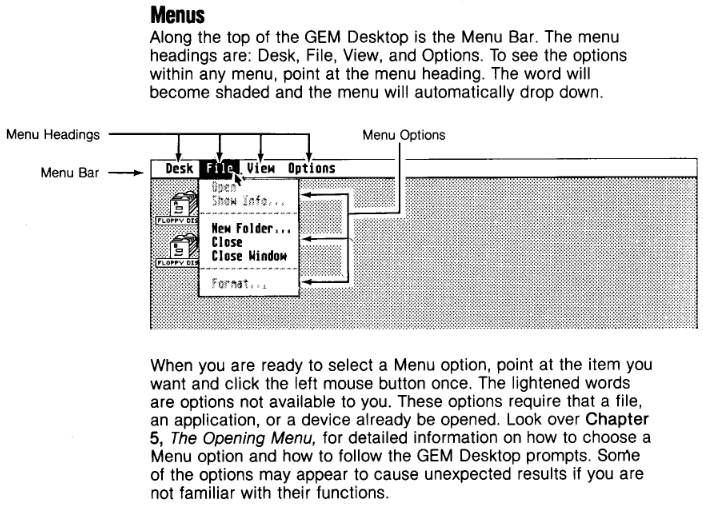Toying with the Idea of 36 bit bitslice computer, I noticed I had a free op code bit I could
use as indirect bit. I was thinking of the PDP 10 indirect, where a new index register
was included in the indirect. Did any software make use of this as well as the muilt-level
indirect?
Indirect + indexing is used. I grepped MIT sources and found many cases.
Multi-level indirect, I’m not sure. It’s difficult to search for that too.
Regarding multi-level indirection: I’ve once seen an old US Air Force coding manual (as a PDF), which stated quite clearly, “Never use more than two levels of indirection.” And I’m quite sure, I’ve never seen anything like that. (I guess, this would become unmaintainable pretty quick.)
The Xerox Alto emulated the Data General Nova with two differences: they replaced the i/o instructions with some extra stuff and they eliminated the multi-level indirection which allowed them to address 128KB instead of 64KB. I think some other Nova clones did the same thing with the argument that nobody had ever found a practical use for that feature.
Interesting! I believe Xerox PARC’s Maxc computers also replaced I/O instructions with other functionality. I get the impression the Alto inherited many techniques from the Maxc.
One of the key things in the Maxc was the use of dynamic memory chips instead of core memory. Their experience with this made them feel that it would be practical to build the Alto.
Dynamic ram, made all home computers possible, look at the APPLE I,
TRS80,and C 64.
I Just read that APPLE took people to court after stealing Xerox’s ideas. Digital Research, Inc (cp/m guys) had better graphics system
than the apple. (gem?)
Regarding Apple and Xerox:
The (in)famous PARC-visit was part of a stock exchange deal between Apple and Xerox (initiated by Xerox), and Apple licensed a lot of stuff from Xerox (including the mouse, while going with their own design). It’s true, Apple developers were aware of what was going on at Xerox, thanks to papers published by PARC and former PARC employees transitioning to Apple, which is, why Apple was interested in the tour in the first place. However, hundreds were given the tour before and Apple even didn’t get the full tour. Notably, there was no such thing as a consistent GUI for the Alto (rather, some applications had a GUI of their own). This, a consistent interface metaphor, only originated with the work done for the Star at Xerox SDD, for which development in earnest had started just around that time. Polaroids from the development of the LISA, taken by Bill Atkinson, show that Apple was prototyping windows even before the PARC visit. And Apple added a lot of things, like direct manipulation.
The quote concerning Apple “stealing” is really by Bill Gates from the “Look-and-Feel” lawsuit of 1988. Apple had granted MS a license on the GUI, with some limitations, with overlapping windows as a red line. As this was crossed, Apple sued, but, as it turned out, Apple had unintentionally granted MS a perpetual license. The outcome had nothing to do with this argument about Apple stealing from Xerox. (As it seems, Windows is still running on this license?)
Some further reading:
-
On “stealing” and the court case, “A Rich Neighbor Named Xerox”: https://www.folklore.org/StoryView.py?story=A_Rich_Neighbor_Named_Xerox.txt
-
On the implications for MacBasic (by MS, may have been one of the nicest BASICs ever, but became a victim to this clash): https://www.folklore.org/StoryView.py?story=MacBasic.txt
-
Bruce Horn “On Xerox, Apple and Progress” (a rather neutral view): https://www.folklore.org/StoryView.py?story=On_Xerox,_Apple_and_Progress.txt
-
Bill Atkinson’s Polaroids: https://www.folklore.org/StoryView.py?story=Busy_Being_Born.txt
Checks the web. Yes it was Gem 1.0 by Digital Research was sued by Apple. (Digital Research - Wikipedia) . Hard to tell in this point in time, if Apple was dominating the market, or did have valid
copywrite problem.
The GEM/1 case seems to have been more nuanced (the claim was not just on the interface as a whole, but also on specific applications and the settlement was actually about DR’s advertising, with only minimal changes to be applied to GEM), here from a Computerworld article from just after the settlement:
In question were GEM Desktop, GEM Paint and GEM Draw, which Apple said mimic the Macintosh interface, Macpaint and Macdraw. Apple claimed GEM as a whole was “substantially similar” to its Macintosh interface, according to Kathleen Dixon, a spokeswoman for Apple in Cupertino, Calif. Digital Research’s cash payment is intended to compensate Apple for GEM advertisements that Apple claimed unfairly played on the program’s similarity to the Macintosh.
[…]
Borrson [Nan Borrson, DR spokeswoman] said GEM’s user interface will remain much the same, but icon locations and other small aspects may be changed. The current version will be on dealers’ shelves until the second release. Owners of the original GEM may opt for an upgrade, and all GEM applications will run under both versions, she said.
Source: https://books.google.at/books?id=w3IudMVoEusC&pg=PA2&redir_esc=y#v=onepage&q&f=false
At the time, trade magazines claimed the lawsuit was a problem for Atari developing it’s Atari ST operating system, which was in part based on GEM.
The key thing that Apple complained about was GEM copying their “pull-down” menus. These allowed you to go to the menu bar at the top of the screen, press the mouse button and the menu would be shown. Still holding the mouse button you could move left and right to rapidly show the other menus or move down to select and item. Releasing the button did the selected action.
DRI had to change the PC version to be different, so you had to click on the menu bar, the menu would be shown then you click a second time on the item to activate it. As far as I know the Atari version flew under the radar and retained the pull-down menus.
